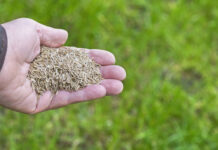Does what happen in California stay in California? The short answer: Not often. California is a trendsetter. Remember the Beach Boys? How about the introduction to the U.S. market of fuel-efficient Japanese cars in the 1970s, which caught Detroit asleep at the wheel? More to the point of our landscape industry, consider California Air Resources Board’s role in the formulation of equipment emissions regulations by the U.S. EPA. Or the popularization of “outdoor living,” a landscape trend pioneered by California contractors.
What happens in California is critically important to the nation and to landscape/lawn service companies, as well. Whether we choose to acknowledge it or not, those of us living and working east of the Golden State often find ourselves affected by what happens there … eventually.
Pay close attention to the next major landscape trends spreading from California, specifically the re-examination of the role of turfgrass in maintained landscapes and the growing demand for landscapes that require significantly less maintenance, including less mowing and chemical use. These trends go hand-in-glove with the specification and installation of native and regionally adapted landscape plant material.
These and related trends, such as use of artificial turf, are gaining momentum in California due in large part to the historic drought now into its fourth year.
“The greatest paradigm shift has been that the drought-tolerant or native landscape has become chic or fashionable. This is California, and those things matter to the Joneses,” says Peter Dufau, president of Dufau Landscape, a full-service company headquartered in Ventura, just north of Los Angeles.

PHOTO: GARDENWORKS INC.
“We have changed our marketing and education to focus on a dramatically different environment and marketplace. The good part is consumers realize they must make changes, so you don’t have to educate them on why making improvements is both good for long-term economics and stewardship of natural resources,” Dufau adds.
Water issues drive change
The shrinking availability and rising cost of water for irrigation is the largest driver of these changes.
This past April 1, California Gov. Gerald Brown issued an executive order demanding a 25 percent reduction of water usage in urban areas statewide. In July, the California Water Commission took landscape water conservation one step further by essentially eliminating grass from new office and commercial buildings and reducing turf at new homes from one-third of the landscaped areas to one-quarter. (Developers do not need to comply with these new lawn restrictions if the landscapes of the homes or businesses they construct are irrigated with recycled water.)
“The majority of our clients want to reduce water consumption in order to be more environmentally and economically sustainable,” explains Raj Brown, director of resource management at Heaviland Landscape Management, Vista, California. “In the past, our clients were most concerned with having beautiful green grass and colorful flowerbeds. While this is still a concern, clients have become increasingly concerned with their water usage. Water costs have risen dramatically and water restrictions are in place throughout the region.”
Brown’s position was developed by the 30-year-old Heaviland Landscape four years ago.
“In 2015 alone, the Resource Management Division has completed more than 200,000 square feet of turf removal renovation projects saving clients millions of gallons of water annually,” reports Brown.
California, as anybody who has seen the movie “Chinatown” recalls, has been struggling to meet its water needs for a century or more. Blessed by sunshine and fertile land, the state rapidly emerged as an agricultural powerhouse early in the 20th Century. The migration to California picked up steam during the Depression as dispossessed Plain Staters headed west, a migration shared with the rest of America by John Steinbeck in his book “The Grapes of Wrath.” By the end of WWII, people, lured by its climate and lifestyle, poured into the state and development exploded.
To meet its growing population and industry, state officials turned California into one of the most hydrologically engineered regions on the earth. Even so, California has never been able to develop enough new water resources to meet demand in times of drought, which are hardly rare in the state.

Additional water sources needed
“Our government must wake up and realize that California’s population has doubled since the last major reservoir was built. The system needs upgrading and we need to put people over fish once and for all,” says Jeff Kollenkark, Ph.D., owner of Turf Doctor doing business as Weed Man Lawn Care. His company is based in Fresno in California’s agriculturally rich Central Valley that, over the last 30 years has averaged a scant 11.5 inches of rain annually.
Adds Peter Dufau, whose company is based just north of Los Angeles: “The drought in California is not just a function of rainfall; it is also a function of politics. Half of California’s water goes to environmental uses and the state has not significantly invested in water resource capture or transference in more than 30 years. The population has nearly doubled in that time.
“We have been below average for 10 years, not the three years most people assume, so groundwater reserves are another huge problem,” Dufau continues. “So, even if it rains heavily this winter, the problem is not going away for a long time, if ever. The reality is that water is going to cost much more, and priorities are going to change.”
In that regard, landscape company owners in other states (Florida and Texas immediately come to mind) are in pretty much the same situation as California. When droughts occur and the water level in lakes and reservoirs fall in these states, the landscape industry is directed to cut back its use of potable water. Most state and federal water systems were designed decades ago and have not kept pace with the growth in development or agricultural needs.
In almost all such cases, turfgrass lawns are singled out as “water wasters,” and water authorities impose watering restrictions, urging property owners to downsize their turfgrass lawns or replace them with drought-tolerant alternatives that require no or very little irrigation. In California, more than 20 local and regional water agencies have spent several hundred million dollars incentivizing property owners in their service areas to reduce the footprint of turfgrass lawns.
But, as most knowledgeable green industry professionals know, turfgrass is not a “water waster.” Some turfgrass species provide attractive cover and environmental benefits even in dry climates. Lawn critics are correct in one sense, however; property owners do waste water on their lawns because they are not knowledgeable about turfgrass or about irrigation. Many have water-inefficient turfgrasses on their properties and rely upon poorly functioning irrigation systems that they basically set-and-forget to water their turfgrass and ornamentals.
The huge challenge of education
The challenge of educating property owners about basic turfgrass care and proper turfgrass irrigation is huge, and one that the state’s green industry has had a hard time accomplishing.
“Most everyone has antiquated nozzles and controllers with high-volume nozzles and limited options on watering multiple times on their two watering days a week,” says Kollenkark, who has been operating Turf Doctor for 15 years. “System upgrades are really where they need to start, and many try to make the old systems work, and they give up after seeing poor-looking lawns and decide not to water anymore or at least drop us as the lawn quality is not worth investing in.”
Kollenkark, who holds a Ph.D. in agronomy from Purdue University, acknowledges that the drought, in addition to Gov. Brown’s spring mandate to reduce urban water use by 25 percent, has caused customers to cancel their lawn care. “Customers really feel peer pressure here as they are told that a brown lawn is ideal. We still have 78 percent of our customer base from the start of the year, but they keep falling off daily. I suspect they feel they need to do their part in conserving water and green lawns are dispensable,” says Kollenkark.
Even so, the great majority of his customers value their lawns, which he insists his company can keep green and healthy by applying the specialized, long-term soil surfactant LT 120 and advising clients on the use of Hydratain, both products assisting in better water distribution and efficiency into the soil and to turfgrass roots.
Being a businessman as well as an agronomist, Kollenkark realizes his company must provide what his market demands. In addition to offering lawn care through his Weed Man franchise, he founded two complimentary businesses – Aqua Man, which pairs irrigation services with lawn care, and Grass Creations, which installs quality synthetic turf lawns.
He says both Aqua Man and Grass Creations have had a steady influx of business. “I still love real grass and the smell and look of fresh-cut grass,” says Kollenkark, his agronomist bias showing. “I love the benefits of real turf and think it has been unjustly demonized.” Even so, he admits that demand for artificial turf lawns is growing throughout California.

PHOTO: GARDENWORKS INC.
“Like everything else, there are good and bad installers and many hidden short cuts that can sting the uninformed consumer,” continues Kollenkark. “Grass Creations will only follow the best installation procedures to ensure a great install for years to come. Most of our jobs have been residential, but there will be a huge wave of commercial and governmental opportunities ahead.” He says that a properly installed lawn using quality artificial turf will return its costs in water savings in as few as five years.
Downsizing rather than eliminating
Rather than abandoning lawns altogether, Peter Estournes, vice president of Gardenworks Inc., says many of his company’s clients in its Sonoma County market north of San Francisco are reducing the size of their lawns.
“Our marketplace, for the most part, is very progressive and environmentally aware. While we still have clients interested in lawns, we find that they can get by with 25 to 30 percent coverage and still be happy, and they typically allow us to design to that criteria,” says Estournes, adding his partner, Jay Tripathi, saw the water crisis developing a decade ago and put the company on notice that it had to begin helping its clients conserve water.
“So we began by requiring our management crews to read and record water meter readings for every visit for every project that had a water meter,” continues Estournes. “We then entered those readings in a simple spreadsheet in order to look for anomalies from visit to visit. When something was noticed we were able to respond and take care of any issue much faster. This endeared us to our clients very quickly.”
Gardenworks’ crews closely worked with clients to establish water budgets for their properties. The process of implementing and monitoring clients’ water budgets revealed that the company had been over-applying fertilizer. Consequently, Gardenworks reduced fertilizer usage by almost half, and still got good results. “We were also moving away from synthetic fertilizers to organic-based types,” says Estournes.
But even the process of using water budgets has had its share of hiccups. “It is extremely frustrating for us to spend a lot of time and resources learning and using water budgeting as it’s prescribed by the state of California only to have them pulled out when cities adopt a two-day-per-week watering restriction,” continues Estournes. “Moving to the current drought, the main challenge we have seen with it is staying current with providing useful information to our clients both by direct contact and our website. Educating our clients without overdoing it and staying up to date with the different restrictions in different cities we work in and around then updating or creating irrigation schedules to match.”
Estournes sees a “market transformation” in California as contractors adopt and implement sustainable practices in designing, installing and managing clients’ landscapes. “Two things all clients ask for is a low-maintenance landscape that is water efficient,” he adds.
Keep paying attention to the California landscape market, the largest landscape market in the U.S., and a powerhouse in terms of trends with its 39 million residents and a $2.4 trillion economy, the eighth largest in the world and representing 13 percent of U.S. GDP.











![[VIDEO] Dickies®: Discover Workwear That’s Anything But Uniform](https://turfmagazine.com/wp-content/uploads/2023/06/1647663814-4b1a2a7742790a9b1e97a3b963477850192e1d6a9dfba9b07214a77bae25d6e3-d-218x150.jpg)






























![[VIDEO] Dickies®: Discover Workwear That’s Anything But Uniform](https://turfmagazine.com/wp-content/uploads/2023/06/1647663814-4b1a2a7742790a9b1e97a3b963477850192e1d6a9dfba9b07214a77bae25d6e3-d-324x160.jpg)